Translate this page into:
A Bibliometric Analysis of Depression and Anxiety in Breast Cancer through the Lens of Oncology and Psychiatry
* Corresponding author: Mr. Mohd Manshoor Ahmed, Pur. PhD, Department of Social Work, Central University of Kerala, Kasaragod, Kerala, India. American Society of Clinical Oncology (ASCO USA). ahmed.ssw072106@cukerala.ac.in
-
Received: ,
Accepted: ,
How to cite this article: Ahmed MM, Rahoof FV, John J, Ul-Nazir A, Dar YM. A Bibliometric Analysis of Depression and Anxiety in Breast Cancer through the Lens of Oncology and Psychiatry. Acad Bull Ment Health. 2025;3:7-24. doi: 10.25259/ABMH_4_2025
Abstract
This study looks at trends in the research on depression, major depressive disorders (MDD), anxiety, and breast cancer. A lot of new research is being done in the areas of oncology and mental health, with a focus on the mental problems that people with breast cancer face. It is common for these people to have depression and anxiety simultaneously. The Scopus database’s 7,430 papers were examined to determine the extent of research, frequency of citations, and the number of collaborations worldwide. The results show that mental health is becoming more critical in the field of cancer. In the initial years, research primarily concentrated on depression and anxiety. Collaborative efforts across borders were notably influential, with roughly one-fifth of studies incorporating international co-authorship. This development emphasizes the global relevance of mental health and cancer research. This shows how mental health and cancer research affects people all over the world. Much more is known about cancer care’s psychological and social aspects, thanks to studies published in critical journals like Psycho-Oncology and the Journal of Clinical Oncology. The positive publication trajectory has seen a decline in recent years, most likely attributable to worldwide disturbances such as COVID-19. This study shows how important it is to continue research across different fields to solve complicated mental health problems faced by cancer patients. It stresses the need for creative psychological treatments and teamwork to improve patient outcomes.
Keywords
Anxiety
Breast cancer
Bibliometric analysis
Depression
Major depressive disorder
Mental health
Oncology
INTRODUCTION
Over the past ten years, there has been a significant increase in the research landscape for breast cancer, major depressive disorders, anxiety, and depression.[1] Researchers have focused on examining complex interactions between these vital health areas, as mental health is increasingly being recognized as an integral element of overall healthcare, especially in cancer.[2] This publication is a bibliometric examination of research trends, outputs, and impacts across various fields from 2010 to 2024. With an estimated 2.3 million new cases in 2020 alone, breast cancer is still the most common cancer diagnosed in women worldwide.[3-5] Breast cancer has a substantial psychological toll, particularly in terms of depression and anxiety.[6] Overall, rates of anxiety and depression symptoms were 73.3% and 68.6%, respectively.[7] Studies show that during treatment or recovery, up to 25–30% of individuals with breast cancer experience clinically significant depression.[8,9] In a similar vein, research indicates that between 40 and 50 percent of women with breast cancer experience anxiety.[10] Cancer patients’ general quality of life, survival, and treatment adherence can all be impacted by mental health conditions such as anxiety and depression.[11,12] Mental health disorders have been linked to poorer prognosis,[13,14] worse health outcomes,[15] and a shorter life expectancy for women with breast cancer. This emphasizes the value of all-encompassing cancer care, which includes mental health treatments and psychosocial support.[16] Interdisciplinary research efforts to address mental health comorbidities in cancer care have significantly increased over the past ten years.[17,18] The key topics, important areas of concentration, and emerging themes in the literature on anxiety, depression, and breast cancer have been highlighted in this analysis. The research environment can now be systematically and quantitatively analyzed thanks to bibliometric techniques, which have shown notable shifts in scientific productivity, citation trends, and international connections. This study used keywords such as “depression,” “major depressive disorder,” “anxiety,” and “breast cancer” to search through 16,776 records retrieved from the Scopus database. The final dataset has 7,430 items after multiple rounds of filtering by language, subject area, and other specific keywords. These records provided valuable information on authorship trends, citation patterns, and annual scientific productivity, pointing to a rise in collaborative research across a range of fields.[19] With international co-authorship present in 19.33% of papers, this analysis demonstrated a high level of international collaboration. With significant contributions from countries like the United States, China, and the United Kingdom, this trend emphasizes the global aspect of research in mental health and oncology.[20,21] The significance of research in these areas is demonstrated by the average citation rate of 28.49 per document. Research on depression, anxiety, and breast cancer has benefited greatly from the work of prestigious journals such as the Journal of Affective Disorders, PLOS ONE, and Breast Cancer Research and Treatment.[22] Additionally, the analysis highlights important authors whose work has improved our knowledge of how psychological factors impact cancer care and survivorship, such as Paul SM and Miaskowski C.[23] With significant ramifications for scholars, professionals, and policymakers in the fields of mental health and oncology, the study’s comprehensive analysis sheds light on the evolving field of research on the psychosocial aspects of cancer care. The study’s analysis of research trends shows that mental health is becoming more widely recognized as a crucial element of all-encompassing cancer treatment.[24] It is critical to emphasize interdisciplinary teamwork and comprehensive treatment approaches as the complexities of mental health disorders in cancer patients are further studied.[25,26] The importance of ongoing research in oncology, depression, and anxiety is highlighted by this bibliometric analysis, along with the need for ongoing innovation in tackling the psychosocial issues associated with cancer therapy.
METHODS AND TOOLS
The review employs a bibliometric method to gain insights into the research trends in these disciplines. Initial data was obtained from the Scopus database. The researchers used the keywords to find absolute information: “depression,” major depressive disorder,” “anxiety,” and “breast cancer,” studies published in 2010 from 2024. The initial search yielded a net total of 16,776 records. The exclusion criteria used for the first filtering method reduced the number of studies to 11,431.
Following this, the researchers focused on specific fields to ensure the contextuality of the study. The chosen areas and related document counts were Medicine (9,565 studies), Biochemistry and Genetics (2,607 studies), Molecular Biology (1,301 studies), Psychology (1,301 studies), Nursing (1,064 studies), Neurosciences (421), and Social Sciences. This selection limited the studies to 10,883. Moreover, the articles published in English were picked, excluding articles in Chinese, French, etc. After this sifting, the data was limited to 7,640 studies. In the final step, the researchers chose publications based on additional keywords: “females,” “breast cancer,” “adult,” “depression,” “pain,” and “anxiety.” This final screening process yielded 7,430 documents (articles). The researchers presumably employed bibliometric tools and techniques to analyze the revised dataset, including bibliometric software RStudio to visualize and analyze citation networks, co-authorship patterns, and keyword co-occurrences. Statistical analysis was performed utilizing tools such as R to undertake quantitative studies of bibliometric data. Visualization techniques, including graphs, charts, and tables, were utilized to depict trends over time, the distribution of studies across subject areas, and other pertinent data. This comprehensive approach enabled the researchers to identify trends, relevant research areas, influential publications, and gaps in the literature on depression, major depressive disorders, anxiety, and breast cancer from 2010 to 2024, see Figure 1.
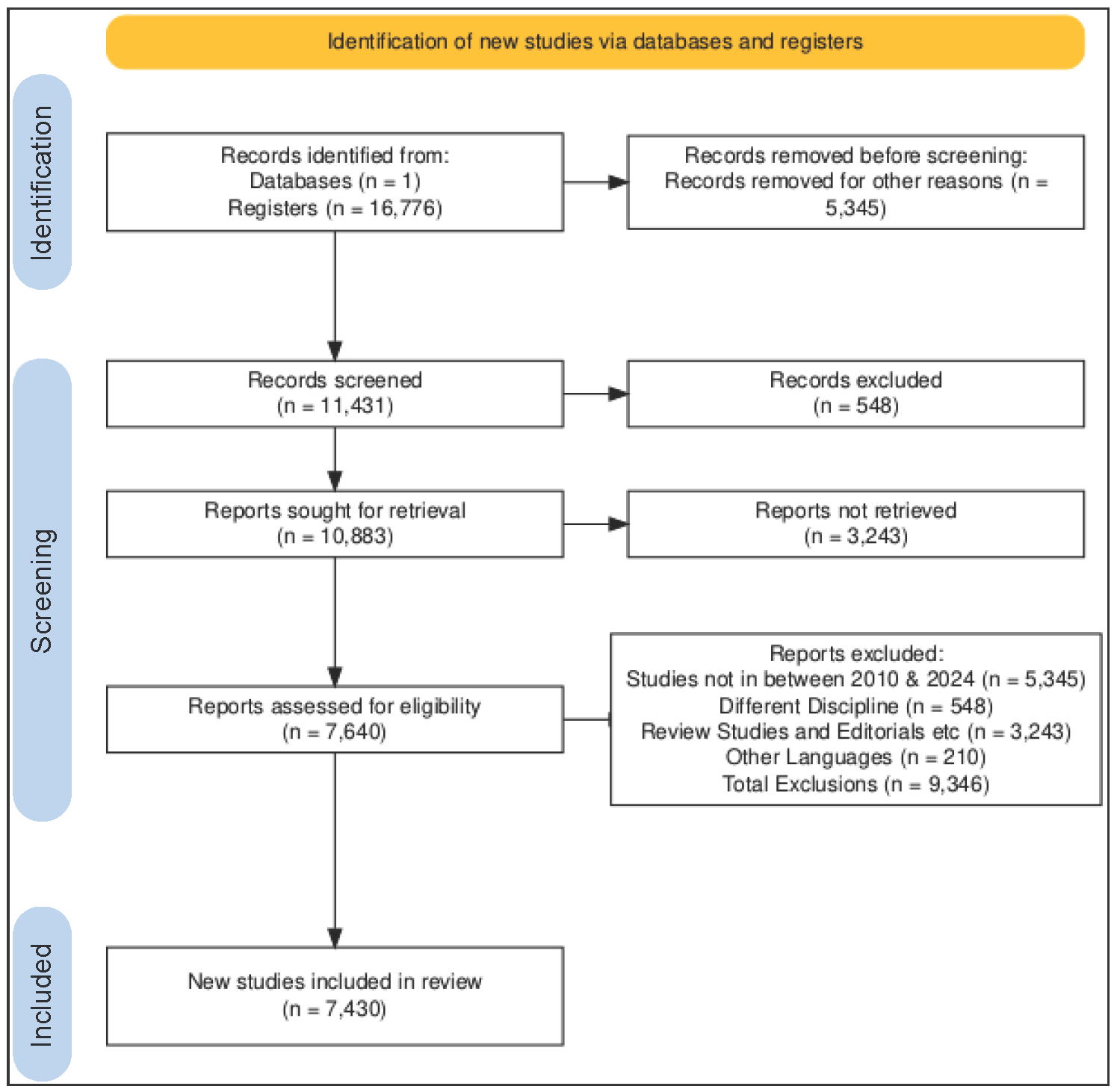
- Preferred reporting items for systematic reviews and meta-analyses (Flowchart).
ANALYSIS AND RESULTS
Overview of the study
The provided Figure 2 summarizes critical metrics from a bibliometric analysis of research trends related to depression, major depressive disorders, anxiety, and breast cancer. The data spans 14 years (2010 to 2024), indicating a broad temporal coverage of research trends in these fields. Data from 1684 sources (journals) have been included, suggesting a wide range of contributions to literature. The analysis comprises 7,429 documents, providing a substantial sample size for identifying trends and patterns. The annual growth rate of 1.27% indicates a steady increase in publications over the examined period, reflecting growing interest and ongoing research. The involvement of 36,430 authors highlights significant collaborative efforts and widespread research activity. Only 215 documents are single-authored, suggesting that most research was conducted collaboratively. With 19.33% of the papers involving international co-authorship, a notable global collaboration indicates broad international interest. On average, each document has 7.57 co-authors, emphasizing the collaborative nature of research in these domains. The authors used 10,024 unique keywords, reflecting diverse topics and subfields within the broader research areas. The total number of references cited across all documents is 268,746, suggesting comprehensive literature reviews and substantial referencing in the publications. The average age of documents is 6.07 years, indicating that the dataset includes both recent and older publications, providing a balanced view of the research landscape. Each document has an average of 28.49 citations, signifying the impact and recognition of the research within the academic community. The bibliometric analysis reveals a robust and growing body of research on depression, major depressive disorders, anxiety, and breast cancer from 2010 to 2024. The field is characterized by high levels of collaboration within and between countries and shows significant academic impact, as evidenced by the average citations per document. The data indicates ongoing and increasing scholarly interest, with a diverse range of explored topics reflected by the numerous unique keywords.
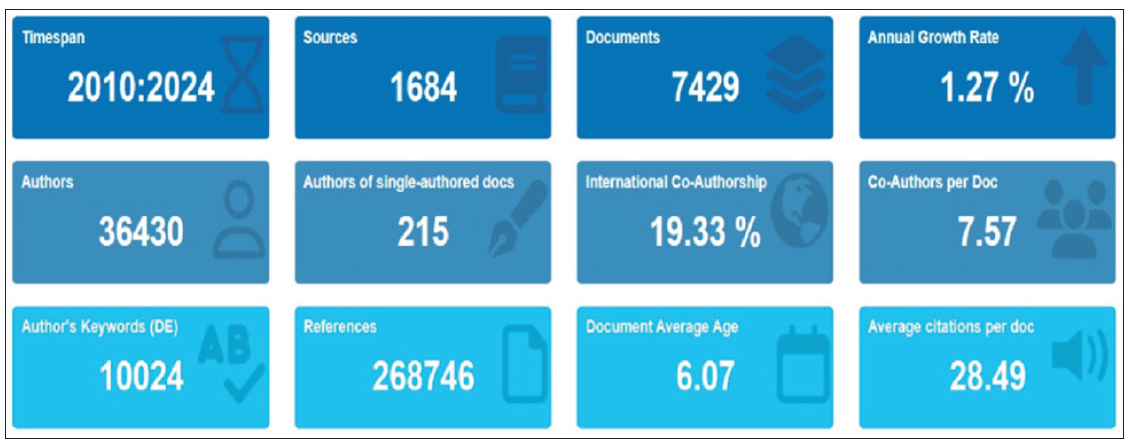
- Main information.
Annual scientific production
The graph titled “Annual scientific production” in Figure 3 shows the number of articles published each year from 2010 to 2024 in the research areas of depression, major depressive disorders, anxiety, and breast cancer. The number of articles published annually increased from 2010 to 2013, indicating a rising interest and increased research activity in these fields. This period likely marks the beginning of growing awareness and funding for research in these areas.
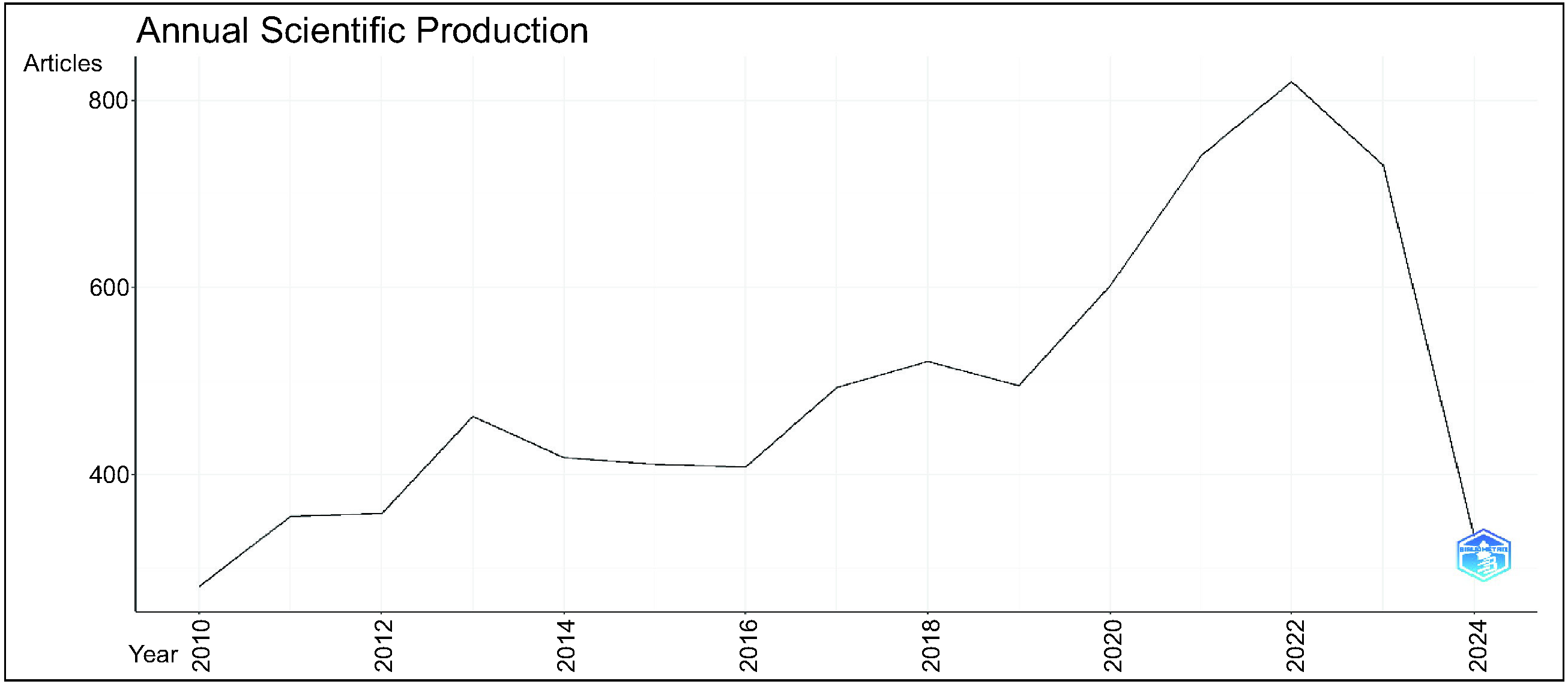
- Annual scientific production.
Figure 3 shows that from 2013 to 2017, the graph exhibits occasional swings but remains reasonably consistent, with about 400-600 articles per year. This stability reflects a steady level of research, with modest annual variations likely due to changes in funding, study focus, or publication rates. There has been a considerable spike in publications from 2018, culminating in 2022 with over 800 articles. This significant growth may be attributable to numerous sources, including the dramatically transforming research landscape in recent years, defined by heightened global awareness of mental health in breast cancer. This trend has been driven by more significant funding and collaborative projects, with technical developments facilitating study and dissemination. The rising emphasis on these areas reflects a broader trend of prioritizing vital health issues. However, recent data from 2023 and 2024 suggest a considerable fall in publications, after a brief increase in 2022. This reduction could be ascribed to numerous situations. Delays or reduction in research funding may have been one of these reasons. Additionally, research agendas or focus area adjustments can shift attention away from formerly prominent themes. The influence of worldwide events, such as the COVID-19 pandemic, could have delayed research activity and publishing timetables. Furthermore, changes in publication regulations or increasing difficulty in achieving demanding publication criteria might also contribute to reduced productivity. While breakthroughs in research and technology have propelled progress in vital health domains, different difficulties and global events have greatly influenced recent publishing trends.
Average citations per year
The graph on “Average Citations Per Year” demonstrates the pattern of citations for research publications connected to depression, major depressive disorders, anxiety, and breast cancer over time. A general upward trend in the average number of citations per year for all areas reflects growing interest and research output. Citations for depression-related studies show a massive increase, starting in the year 2012, and peaking between 2015 and 2018. This peak reflects strong research activity and substantial discoveries in the field. Research on major depressive disorders (MDD) exhibit a sharp growth in citations starting around 2012, with a notable peak from 2016 to 2019. This increase suggests a growing focus on MDDs in the research community. Anxiety research citations show a continuous increase, with notable growth starting around 2014 and peaking between 2016 and 2019. This consistent rise suggests persistent interest and the importance of anxiety-related studies. Research on breast cancer reveals an early start, with a dramatic spike in citations beginning in the late 2000s. The peak phase roughly spans 2015-2018, followed by stabilization. This trend highlights important advancements and continued research in breast cancer. From 2000 to 2005, small citation numbers across all categories reflect early research periods or lower publication rates. The years 2011 to 2015 saw a surge in citations, especially for depression and breast cancer research, indicating heightened research activity and potentially significant discoveries or breakthroughs. From 2016 to 2020, the peak citation years for most categories, particularly MDD and anxiety, represent significant research activity and the publication of influential papers. Between 2021 and 2024 some domains saw stabilization or minor reductions, suggesting a maturation of the research topics. Given the current scenario, it is necessary to address specific areas of concern as the suffering of patients continues to grow. The prevalence of mental health issues among these individuals has reached unprecedented levels, highlighting an urgent need for focused intervention, support, and restarting intensive research[27-29] and then or a shift in focus to emerging topics. The Figure 4 and Table 1 collectively highlight the evolving landscape of research in depression, MDD, anxiety, and breast cancer. Key observations include research peaks for depression and breast cancer around 2015-2018 and for MDD and anxiety around 2016-2019. A steady increase in citations across all fields from 2010 to 2020 indicates growing interest and investment in these research areas. Filtering studies to include those in English and limited to specific subject areas (medicine, biochemistry, genetics, etc.) highlights the importance of these criteria in refining research focus and citation analysis. This analysis demonstrates the dynamic nature of research trends in mental health and cancer, with significant growth phases reflecting the research community’s response to emerging challenges and advancements in these fields see Figure 4 and Table 1.
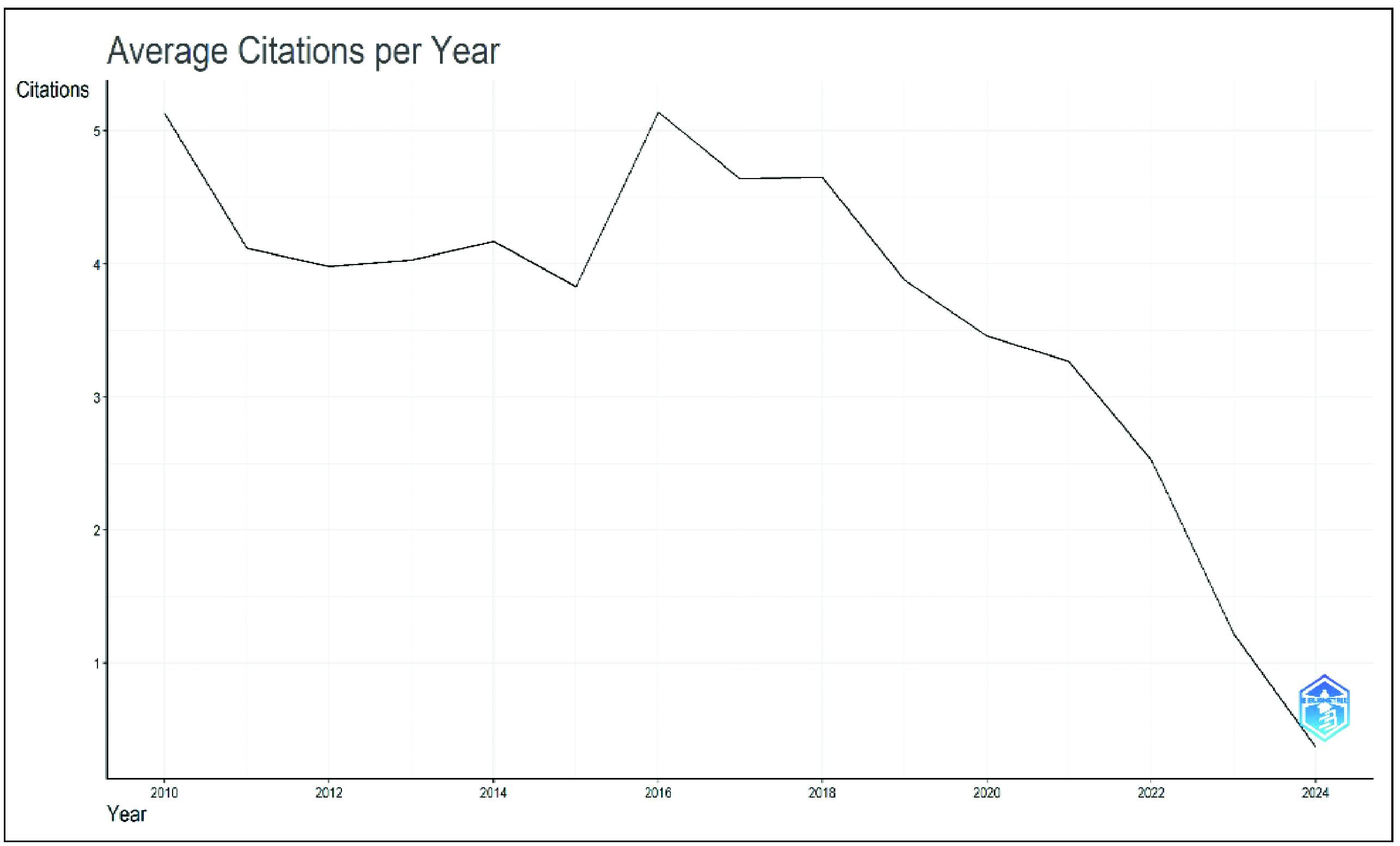
- Average citations per year. Source: Scopus
| Year | Mean TC per art | N | Mean TC per year | Citable years |
|---|---|---|---|---|
| 2024 | 0.37 | 334 | 0.37 | 1 |
| 2023 | 2.44 | 731 | 1.22 | 2 |
| 2022 | 7.60 | 820 | 2.53 | 3 |
| 2021 | 13.07 | 741 | 3.27 | 4 |
| 2020 | 17.31 | 602 | 3.46 | 5 |
| 2019 | 23.31 | 495 | 3.88 | 6 |
| 2018 | 32.53 | 521 | 4.65 | 7 |
| 2017 | 37.09 | 493 | 4.64 | 8 |
| 2016 | 46.26 | 408 | 5.14 | 9 |
| 2015 | 38.32 | 411 | 3.83 | 10 |
| 2014 | 45.83 | 418 | 4.17 | 11 |
| 2013 | 48.32 | 462 | 4.03 | 12 |
| 2012 | 51.75 | 358 | 3.98 | 13 |
| 2011 | 57.75 | 355 | 4.12 | 14 |
| 2010 | 76.88 | 280 | 5.13 | 15 |
TC: Total citations
CORE SOURCES BY BRADFORD’S LAW
This study’s core sources, identified by Bradford’s Law[30] are pivotal as they concentrate on the most influential research articles. Analysis of core sources using Bradford’s law revealed the most relevant articles in distributing scientific publications. As seen in Figure 5, most publications focused on the first zone, with leading journals such as the Journal of Oncology and Quality of Life Science Research being critical. This suggests that these journals are crucial in disseminating research on the topic, although other relevant sources exist. However, the journals from supportive cancer to breast cancer research have displayed critical information.

- Core sources by Bradford’s law. Source: Scopus
Sources’ local impact
Figure 6, titled “Sources” Local Impact by H Index”, ranks academic journals by their H-index, representing both productivity and citation impact. Psycho-Oncology leads with the highest H-index of 64, closely followed by the Journal of Clinical Oncology at 63. Supportive Care in Cancer has an H-index of 45, while Breast Cancer Research and Treatment stands at 41. Cancer has an H-index of 39, and the Journal of Pain and Symptom Management has a significant H-index of 34. Other major journals include Breast and Cancer Nursing at 27, BMC Cancer at 26, and the European Journal of Cancer at 25. The H-index measures the number of publications that are cited at least as many times as the index value. Higher H-index values imply more important and extensively cited works. Based on citation metrics, this graphic demonstrates the relative effect of various oncology and mental health publications.

- Sources’ local impact.
Sources’ production over time illustrates the cumulative occurrences of research papers from numerous sources throughout time, specifically focusing on depression, major depressive disorders, anxiety, and breast cancer. The graph indicates a significant increase trend in publications across all sources from 2010 to 2024. This reflects a growing research interest and production in the investigated domains. Journal of Clinical Oncology: This source has the most cumulative occurrences, progressively increasing from 2010 to 2024. The Journal of Clinical Oncology plays a crucial role in research at the interface of oncology and mental health. Psycho-Oncology has shown a tremendous increase, especially post-2015, showing rising interest in the psychological aspects of oncology. Supportive Care in Cancer exhibits a moderate increase, highlighting the continued study into mental health components of supportive care for cancer patients. Breast disease Research and Treatment demonstrates sustained, though slower, progress, contributing consistently to the study of both disease and its psychological repercussions. BioMed Central (BMC) Cancer, while less in volume, continues to contribute to cancer research with occasional focus on mental health. Together, these periodicals emphasize the convergence of oncology and mental health, with increased attention to holistic care techniques also see Figure 7 and Table 2 for further understanding.

- Source of production over time. BMC: BioMed Central.
| Element | h_index | g_index | m_index | TC | NP | PY_start |
|---|---|---|---|---|---|---|
| Psycho-oncology | 64 | 87 | 4.267 | 13780 | 425 | 2010 |
| Journal of clinical oncology | 63 | 97 | 4.200 | 13283 | 97 | 2010 |
| Supportive care in cancer | 45 | 67 | 3.000 | 8690 | 428 | 2010 |
| Breast cancer research and treatment | 41 | 68 | 2.733 | 5736 | 176 | 2010 |
| Cancer | 39 | 72 | 2.600 | 5560 | 92 | 2010 |
| Journal of pain and symptom management | 34 | 56 | 2.267 | 3944 | 164 | 2010 |
| Breast | 27 | 39 | 1.800 | 3209 | 79 | 2010 |
| Cancer nursing | 27 | 46 | 1.800 | 2580 | 94 | 2010 |
| Bmc cancer | 26 | 45 | 1.733 | 3739 | 95 | 2010 |
| European journal of cancer | 25 | 39 | 1.667 | 1549 | 40 | 2010 |
TC: Total citations, NP: Number of publications, PY: Number of years, h-index: Hirsch index, g-index: Egghe index, m-index: M-quotient
INTERPRETATION
Research Focus and Trends: The increasing number of articles across all sources reflects a growing acknowledgement of the role of mental health in cancer care. This mirrors a broader trend in medical research that understands the link between physical and mental health. Large contributions from sources such as the Journal of Clinical Oncology and Psycho-Oncology demonstrate that these journals play a crucial role in promoting research at the interface of oncology and mental health. Impact of Major Sources: Leading sources, like the Journal of Clinical Oncology, play a vital role in creating the research landscape, likely due to their vast readership and great impact within the medical community. The contributions from Psycho-Oncology show particular attention to psychological issues, which is vital for holistic cancer care.
COLLABORATIVE AND INTERDISCIPLINARY RESEARCH
The diverse sources contributing to cumulative research output demonstrate the interdisciplinary nature of the study of depression, major depressive disorders, anxiety, and breast cancer. This interdisciplinary approach is essential for developing holistic treatment plans that address patients’ physical and psychological needs. The “Sources’ Production over Time” graph effectively illustrates the growing body of research in the fields of depression, major depressive disorders, anxiety, and breast cancer, with significant contributions from key journals and sources. The upward trends across all sources highlights the increasing recognition of the importance of integrating mental health considerations into oncology research and treatment, fostering a more comprehensive understanding of patient care.
MOST RELEVANT AUTHORS
The picture illustrates the most prominent writers in the study “Bibliometric Analysis of Research Trends in Depression, Major Depressive Disorders, Anxiety, and Breast Cancer.” On the y-axis, writers like MIASKOWSKI C, PAUL SM, LI Y, WANG Y, GANZ PA, ZHANG Y, ZHANG J, ZHANG L, LI J, and BOWER JE are listed, while the x-axis represents their document contributions. MIASKOWSKI C leads with 79 papers, followed by PAUL SM (56), LI Y and WANG Y (54 apiece), and GANZ PA (53). Other prominent authors are ZHANG Y (50), ZHANG J (45), ZHANG L (44), LI J (43), and BOWER JE (42). The frequent occurrence of writers with surnames like Zhang and Li shows collaboration between research groups. These prolific authors play active roles in promoting research on depression, anxiety, and breast cancer. Identifying these critical contributors provides insight into research patterns, with MIASKOWSKI C being the most prominent. Further research on citation effect and institutional affiliations could shed light on the broader influence of these authors [Figure 8].
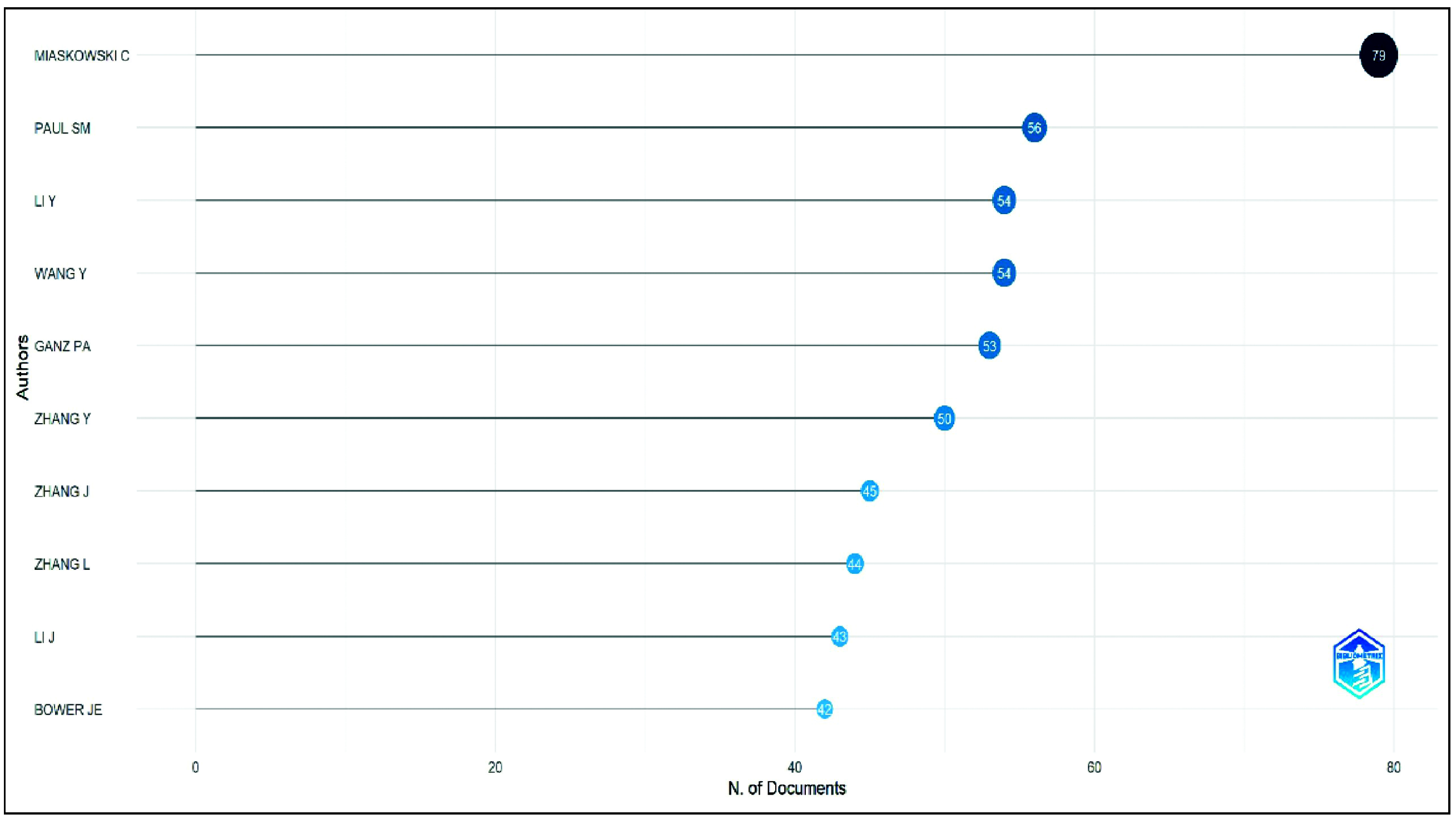
- Most relevant authors.
AUTHORS’ PRODUCTION OVER TIME
Figure 9 depicts the production of articles by the most relevant authors over time within the context of research on depression, major depressive disorders, anxiety, and breast cancer. The y-axis lists the authors, and the x-axis represents the years from 2010 to 2024. Each dot corresponds to the number of articles produced in a particular year, with the size of the dot indicating the number of articles (N. Articles) and the color intensity representing the total citations per year (TC per Year). MIASKOWSKI C has demonstrated consistent production over the years, with notable peaks around 2016 and 2018. PAUL SM also has a steady output, with significant contributions in recent years. LI Y and WANG Y display similar trends, with consistent contributions throughout the observed period. GANZ PA, ZHANG Y, ZHANG J, and ZHANG L exhibit periodic peaks in production, indicating periods of increased research activity. The size of the dots indicates that most authors maintain a steady output of around 5 articles per year, with occasional years where production reaches or exceeds 10 articles. The color intensity reveals that the citation impact of these articles varies, with some years showing higher citation counts, particularly for MIASKOWSKI C. and PAUL SM. Overall, the Figure 9 highlights the sustained and impactful contributions of these authors to the research fields of depression, major depressive disorders, anxiety, and breast cancer over the past decade and a half.
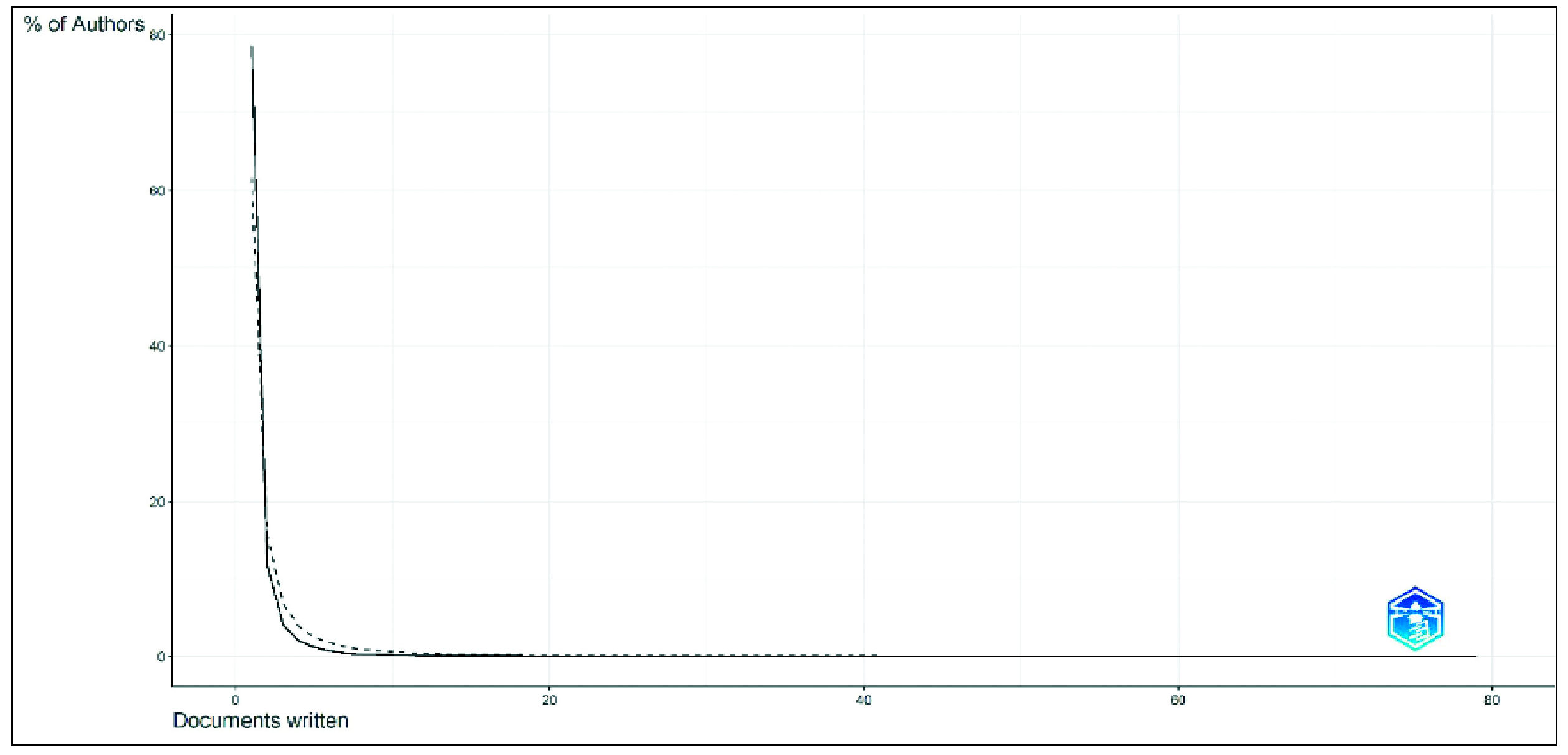
- Authors’ production overtime.
Author productivity through Lotka’s Law: Figure 10 provides a snapshot of author productivity for 2024 based on Lotka’s Law, which often describes the frequency distribution of scientific productivity. In 2024, BOWER JE published 1 article, which received no citations, accounting for 100% of their publications. Similarly, GANZ PA and LI J published 2 articles each, with 100% of their publications receiving no citations. LI Y also published 2 articles, with one article (50%) receiving citations and the other (50%) receiving no citations. MIASKOWSKI C and PAUL SM published one article each, with 100% of their publications receiving no citations. WANG Y published 6 articles, with 5 articles (83.33%) receiving no citations and one article (16.67%) receiving citations. ZHANG J published 7 articles, with 100% receiving no citations. ZHANG L published 1 article with no citations, representing 100% of their publications. Finally, ZHANG Y published 11 articles, with 10 articles (90.91%) receiving no citations and 1 article (9.09%) receiving citations. In 2024, a total of 34 articles were published across various authors. Of these, 30 articles (88.24%) received no citations, while only 4 (11.76%) received citations. This indicates that most publications remained uncited.
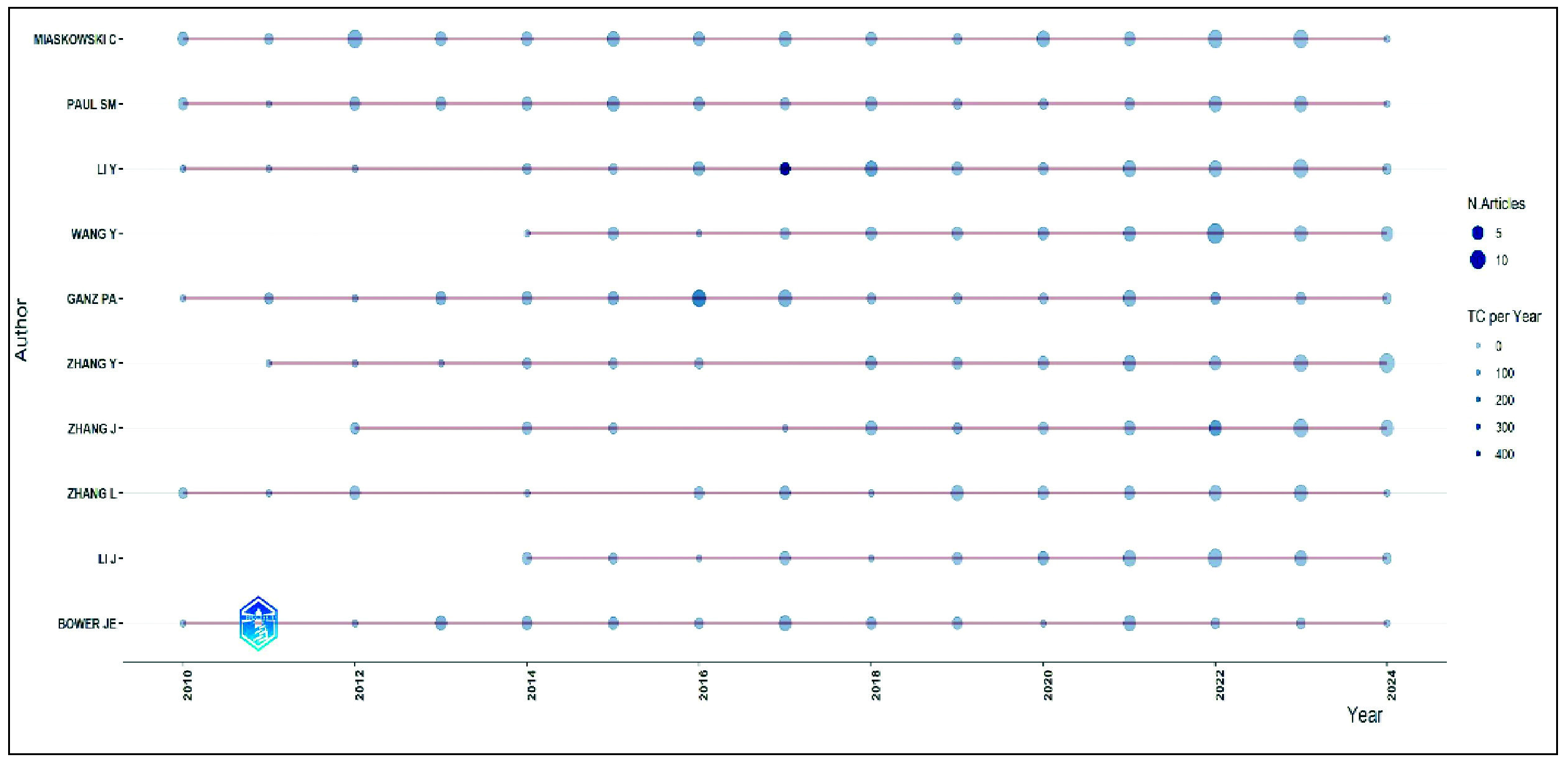
- Author productivity through Lotka’s law.
CORRESPONDING AUTHOR’S COUNTRIES
The bibliometric analysis explores research trends, patterns, and collaborations in the fields of depression, major depressive disorders, anxiety, and breast cancer. By examining keywords such as “females,” “breast cancer,” “adult,” “depression,” “pain,” and “anxiety,” the study delves into the scientific output and
Figure 11 shows the geographical distribution of corresponding authors from different countries. The USA leads in publications on mental health and oncology, with over 2,000 documents, demonstrating significant concentration and resources. China follows with robust domestic research effort but less international collaboration. Other countries, like Australia, Canada, the UK, and Germany, also contribute considerably, balancing single-country publications with international partnerships. While the USA and China have robust national outputs, countries like Canada and the UK show more international cooperation. The study’s focus, particularly on female breast cancer patients and associated mental health disorders, underscores the need for sustained global collaboration and multidisciplinary efforts for more complete care approaches.

- Corresponding author’s countries.
MOST CITED COUNTRIES
The bibliometric study identifies the top-cited countries in research on depression, anxiety, and breast cancer. The USA leads with 82,257 total citations, followed by China (9,359) and Australia (9,126). Notable contributions include Canada, the UK, and the Netherlands. Switzerland stands out with the highest average citations per paper (89.80), indicating outstanding research quality. The analysis underlines the USA’s supremacy and proposes that foreign collaborations could boost research influence globally.
MOST GLOBAL CITED DOCUMENTS
Figure 12 depicts the most cited nations in the study fields of depression, major depressive disorders, anxiety, and breast cancer. The United States leads strongly with 82,257 citations, making it the most influential country in these academic disciplines. China is the second most mentioned country, with 35,112 citations, while Australia ranks third with 12,308 citations. In other countries like Canada, the

- Most global cited documents.
The table presents the most commonly occurring words in a dataset, showing terms largely linked with demographic and health concerns. The phrase “female” leads with 11,253 occurrences, suggesting a significant focus on female issues. Other often stated phrases include “adult,” “human,” and “middle aged,” implying a demographic emphasis on adults and middle-aged individuals. Health-related phrases such as “depression,” “breast cancer,” and “anxiety” are particularly prominent, highlighting significant areas of research interest within the dataset. This means that the research largely addresses mental and physical health issues among adult and middle-aged female populations.
MOST FREQUENT WORDS
Figure 13 presents a dataset’s most commonly occurring words, showing terms largely linked with demographic and health concerns. The phrase “female” leads with 11,253 occurrences, suggesting a significant focus on female issues. Other often stated phrases include “adult,” “human,” and “middle aged,” implying a demographic emphasis on adults and middle-aged individuals. Health-related phrases such as “depression,” “breast cancer,” and “anxiety” are particularly prominent, highlighting significant areas of research interest within the dataset. This means that the research largely addresses mental and physical health issues among adult and middle-aged female populations.
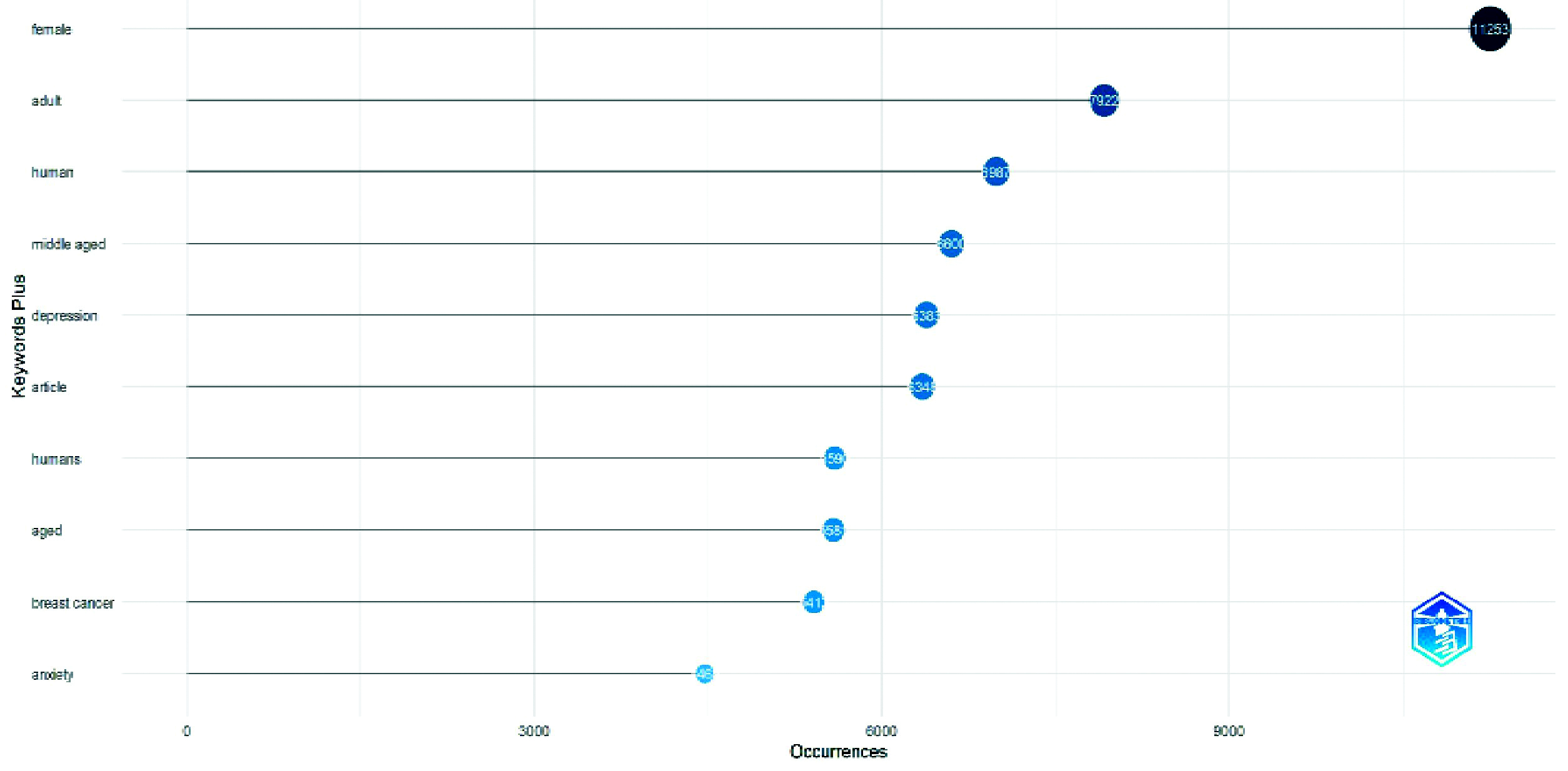
- Most frequent words.
WORDS’ FREQUENCY OVER TIME
As we can see in Figure 13, In research related to anxiety, depression, and cancer, the term “female” appears more frequently than “adult” or “human,” indicating a predominant focus on female subjects. This trend has been consistent since 2010, highlighting that most studies have concentrated on females. Research on anxiety and depression has shown a substantial increase over time. In 2010, the keyword frequencies for “anxiety” and “depression” were 144 and 229, respectively [Table 3].
| Year | Female | Adult | Human | Middle aged | Depression | Article | Humans | Aged | Breast cancer | Anxiety |
|---|---|---|---|---|---|---|---|---|---|---|
| 2024 | 11223 | 7922 | 6987 | 6600 | 6338 | 6348 | 5590 | 5581 | 5412 | 4469 |
| 2023 | 10784 | 7103 | 6883 | 6375 | 6152 | 6037 | 5374 | 5841 | 5171 | 4273 |
| 2022 | 10360 | 7060 | 6020 | 6070 | 5600 | 5474 | 4878 | 5104 | 4601 | 4043 |
| 2021 | 9873 | 6473 | 5276 | 5737 | 4926 | 4804 | 4312 | 4762 | 4058 | 3814 |
| 2020 | 8763 | 6136 | 4594 | 5251 | 4392 | 4187 | 3720 | 4331 | 3524 | 2902 |
| 2019 | 6760 | 5099 | 4021 | 4699 | 3800 | 3671 | 3336 | 3881 | 2772 | 2509 |
| 2018 | 5418 | 4075 | 3061 | 3551 | 2862 | 2838 | 2551 | 2580 | 2203 | 1867 |
| 2017 | 4214 | 3586 | 3061 | 3351 | 2626 | 2636 | 2551 | 2500 | 2020 | 1867 |
| 2016 | 4015 | 3327 | 2590 | 2684 | 2533 | 2427 | 2482 | 2470 | 2012 | 1551 |
| 2015 | 3869 | 2853 | 2197 | 2173 | 2036 | 2086 | 1831 | 2065 | 1716 | 1318 |
| 2014 | 2813 | 1796 | 1398 | 1639 | 1603 | 1751 | 1486 | 1418 | 1147 | 1138 |
| 2013 | 2090 | 1389 | 1101 | 1310 | 1485 | 1504 | 1126 | 1231 | 1118 | 913 |
| 2012 | 1510 | 968 | 608 | 496 | 511 | 609 | 499 | 650 | 473 | 573 |
| 2011 | 960 | 436 | 267 | 227 | 229 | 265 | 200 | 254 | 145 | 144 |
By 2024, these frequencies had risen significantly to 4,469 for anxiety and 6,383 for depression, demonstrating a continuous upward trend without any decline in the intervening years. The data also reflects a steady increase in breast cancer research since 2010, with no decrease in frequency. Additionally, the term “middle-aged” has been more commonly used than “aged” since 2015, whereas the term “aged” was more prevalent from 2010 to 2014. Comparatively, research on depression has been more extensive than on anxiety.
TREND TOPICS
Figure 14 highlights recent research trends. In 2024, the key themes include RNA sequencing, cyclosporine, and breast cancer. However, these issues have not yet acquired the level of knowledge shown in preceding trends. Significant trends began to surface in 2016, concentrating on “aged 80 and over patients.” This pattern lasted until 2022, when the keyword “female” peaked. From 2010 to 2015, research patterns were very steady. A similar consistent pattern has been observed from 2023 onward. During the COVID-19 epidemic, cancer research frequently incorporated the phrase “coronavirus.” In 2020, phrases such as “anxiety,” “anxiety disorders,” and “quality of life” were highly common. In 2018, research focused on age groups and breast neoplasms. The year 2017 emphasized subjects like “psychological well-being,” “stress,” and “psychological factors,” while in 2016, the focus was on “follow-up studies,” “cancer survivors,” and “psychological adaptations.” Overall, the data demonstrates evolving research interests, with significant shifts in focus over time, from age-related themes to new breakthroughs in cancer research and psychological well-being.

- Trend topics.
COUNTRIES’ COLLABORATION WORLD MAP
Figure 15 displays countries’ collaboration; it is apparent that there are transcontinental collaborations. Research collaborations exist between Canada and Mexico, Brazil, Colombia, Peru, and Argentina, spanning North America and South America. Collaborations of the USA and Canada with South Africa are more apparent. South Africa has the most studies in the African continent.
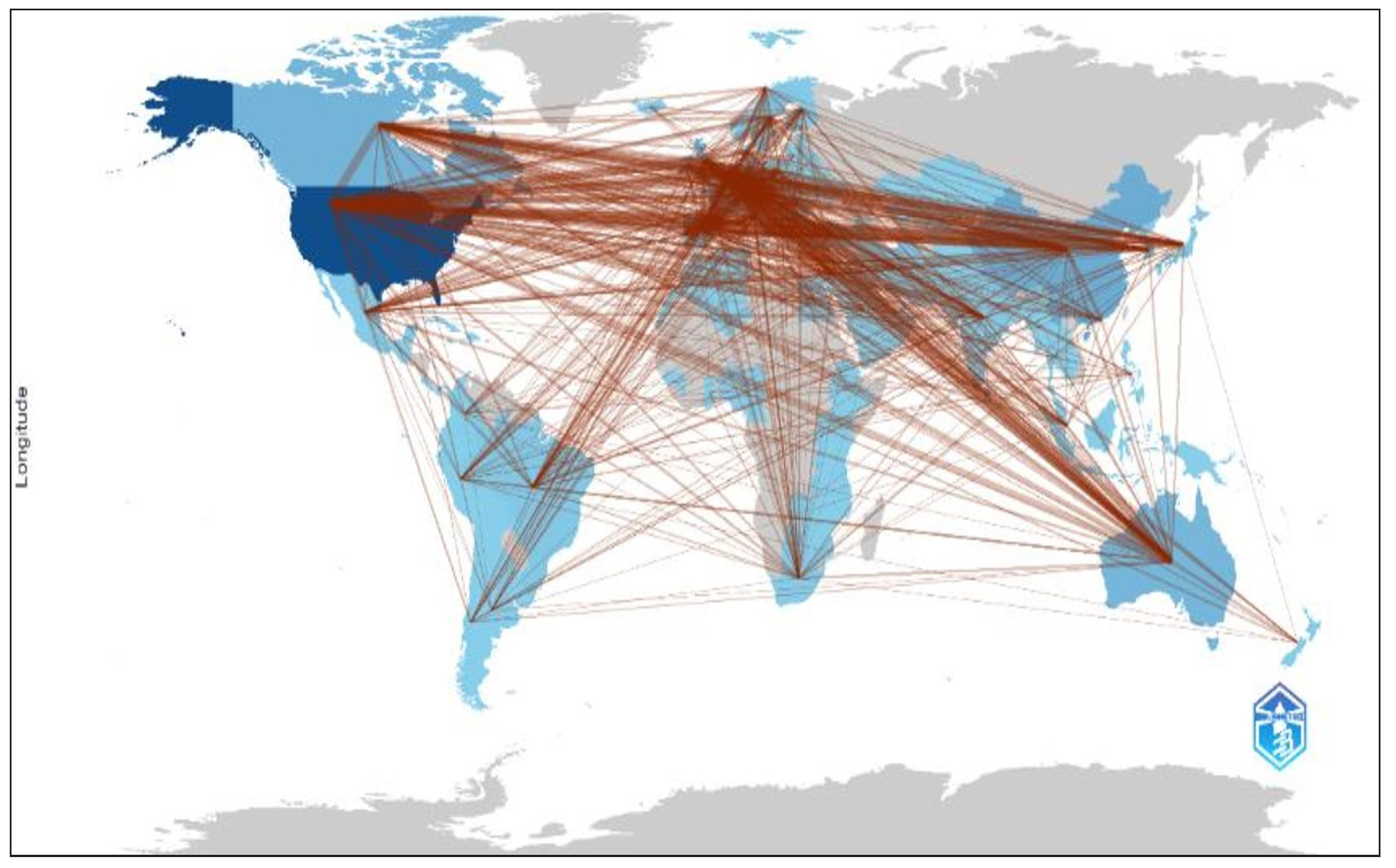
- Countries’ collaboration world map.
European partnership in Asia, Japan, India, Singapore, Malaysia, South Korea, and China was observed. Most of the collaboration from North America is centered in the Chinese region. South Africa showed the most significant collaborations with the rest of the globe. The South American collaborations were seen in nations where studies from Brazil partnered with Sweden, Finland, and Norway, and the collaboration from North American countries was with Asian and African countries. Australia showed collaborations across the globe. New Zealand also collaborates with the US and Canada. The US has the most collaborative studies globally, while Russia has the least.
CO-CITATION NETWORK
Figure 16 illustrates the co-citation network visualising the important research linkages in the field of mental health, with AS Zigmond 1983 standing out as a central player due to his development of the Hospital Anxiety and Depression Scale. This network displays dense clusters around Zigmond and other notable works like the DSM, indicating a considerable concentration on psychological assessments and mental health diagnostics. The illustration also demonstrates the interplay.

- Co-citation network.
Psychological research and therapeutic applications, notably in how mental health disorders are measured and comprehended in clinical settings.
COLLABORATION NETWORK
Figure 17 shows that the Collaboration Network picture displays the interconnected research relationships within a certain topic. Christine Miaskowski shines out as a prominent player, her multiple links highlighting her influential and multidisciplinary position across various academic disciplines. The Red Cluster focuses on cancer care and symptom management, highlighted by researchers like Bruera E and Cohen I; the Blue Cluster, involving Antoni MH and Winer EP, delves into the psychological impacts of illness and therapeutic approaches; the Purple Cluster, led by Levine JD alongside Miaskowski, centers on pain management and neurological studies. Miaskowski’s positioning at one end of the network implies she connects numerous specialized issues, indicating a broad influence. The tight ties within the red cluster imply a robust and collaborative study area. In contrast, peripheral individuals like Kim J and Kim S signal new researchers or novel crossings in subject inquiry. This network vividly displays the dynamics of academic collaboration, revealing core study areas and emerging trends, thus demonstrating how expertise is exchanged and evolved among specialists in the field.

- Collaboration network.
DISCUSSION
This bibliometric analysis demonstrates multiple noteworthy trends in research on depression, major depressive disorders (MDD), anxiety, and breast cancer across the period from 2010 to 2024. It presents an insightful overview of the evolving landscape of mental health in cancer, showing the increased knowledge of the enormous psychosocial burden suffered by patients. The findings underscore the necessity for interdisciplinary research to resolve cancer care’s physical and psychological challenges.
The results of this analysis reveal an upward trajectory in the number of research publications focused on the confluence of breast cancer, depression, anxiety, and related mental health problems. Between 2010 and 2022, the era experienced a steady rise in publications, particularly after 2015, culminating in 2022. This spike likely reflects many causes, including the rising incidence of mental health awareness, the integration of psychosocial care with oncology, and the promotion of holistic healthcare approaches.[31] Mental health challenges in breast cancer patients, such as depression and anxiety, have been documented to affect treatment results negatively, adherence, and overall quality of life.[32] This underscores the critical need for comprehensive cancer care that encompasses both the psychological and physical well-being of patients.[33] In this analysis, we noticed that publications on depression and anxiety in breast cancer patients have gained significant attention, further emphasizing the global focus on mental health integration into oncology care.
INTERNATIONAL COLLABORATION AND GLOBAL RESEARCH TRENDS
One of the primary outcomes of this bibliometric analysis is the large amount of international collaboration in the sector.[34] Approximately 19.33% of the studies featured international co-authorship, showing the worldwide character of research on mental health in oncology.[35,36] Countries such as the United States, China, and the United Kingdom emerged as essential contributors to this corpus of literature, suggesting a solid research network dedicated to tackling these vital health concerns.[37] The significance of international collaboration demonstrates that research on depression, anxiety, and breast cancer is not restricted to any particular place but rather a global concern. This is remarkable given the universal challenges that mental health conditions bring to cancer patients, as indicated by various research in this study.[5] The collaborative character of the research also underscores the need for shared knowledge and resources to face the profound interrelationships between mental health and cancer outcomes.
PSYCHOSOCIAL IMPACT ON TREATMENT AND SURVIVORSHIP
The results of this study complement existing literature on the substantial psychological burden suffered by breast cancer patients. Depression and anxiety, which afflict up to 30% and 40-50% of breast cancer patients, respectively, have substantial implications for survivorship, with mental health difficulties generally related to poorer prognoses.[11] Patients suffering from these conditions may experience less motivation to adhere to treatment regimens, higher pain perception, and diminished immune function, all of which can severely affect cancer recovery.[6] This bibliometric analysis also found crucial sources such as the Journal of Affective Disorders and Psycho-Oncology. These are pivotal in improving our understanding of how psychosocial factors influence cancer care. These publications have contributed considerably to the literature on the interaction between mental health and oncology, stressing the importance of continuous research in this sector.[38]
TRENDS IN RESEARCH PRODUCTIVITY AND IMPACT
The data suggested that while the number of publications grew considerably, notably in the years leading up to 2022, there was noticeable reduction in productivity in 2023 and 2024. This could be linked to numerous factors, including alterations in research financing, shifting publication standards, or disruptions generated by global events such as the COVID-19 pandemic.[39] Nevertheless, the increased interest in these domains remains obvious, as indicated by the growth in average citations per document, highlighting the influence of this research on the scientific community.[40] Regarding citation trends, the data reveals that studies on depression and breast cancer attracted the most attention, with a peak in citations between 2015 and 2018. This aligns with significant gains in understanding the psychosocial components of cancer care throughout this period.[11] Major depressive disorders and anxiety also observed a significant boost in study interest, reflecting the heightened awareness of these conditions in the context of cancer care.[41]
GAPS AND FUTURE DIRECTIONS
Despite the progress obtained in understanding the psychological implications of breast cancer, there remain gaps in the research, notably in addressing therapies that can successfully ease the psychosocial burden of cancer patients.[15,42] While research has advanced in detecting the occurrence and influence of mental health disorders, fewer studies have centered on generating and testing particular therapies suited to the requirements of breast cancer patients. Furthermore, although this investigation demonstrates a strong focus on female breast cancer patients, there is a relative shortage of papers addressing male breast cancer patients or those with different cancer types. Future studies should strive to broaden their reach to cover various patient populations and cancer types to give complete and inclusive care options. Moreover, it has been noted that such study papers are scarce in the country, especially Russia.
CONCLUSION
In conclusion, our bibliometric study demonstrates that research on depression, anxiety, and breast cancer has expanded considerably over the past decade, with a noteworthy increase in international collaboration and academic influence. As the complexity of mental health disorders in cancer patients continues to be addressed, the integration of psychosocial therapy within oncology remains crucial. This study concludes that interdisciplinary teamwork and inventiveness in managing the psychosocial challenges associated with cancer care are crucial. Moving forward, continuous investment in mental health research is critical to improving outcomes for breast cancer patients and boosting the quality of life for those navigating the confluence of mental health and oncology.
Authors’ contributions
MMA, FVR: Conceptualization, interpretation, analysis, and writing of this study. Their intellectual leadership and dedication were central to the development of this manuscript; JJ: Academic guidance and support throughout the research process; AUN, YMD:Contributed in reviewing and refining the clinical and psychological aspects of the manuscript. Their expert insights added significant depth to the interdisciplinary nature of the study.
Ethical approval
Institutional Review Board approval is not required.
Declaration of patient consent
Patient’s consent not required as there are no patients in this study.
Financial support and sponsorship
Nil.
Conflicts of interest
There are no conflicts of interest.
Use of artificial intelligence (AI)-assisted technology for manuscript preparation
The authors confirm that they have used artificial intelligence (AI)-assisted technology for assisting in the writing or editing of the manuscript or image creations.
REFERENCES
- Prevalence and Persistence of Anxiety and Depression Over Five Years Since Breast Cancer Diagnosis—The NEON-BC Prospective Study. Current Oncology. 2022;29:2141-53.
- [CrossRef] [PubMed] [PubMed Central] [Google Scholar]
- Depression and Anxiety Among People Living with and Beyond Cancer: A Rowing Clinical and Research Priority. BMC Cancer. 2019;19
- [Google Scholar]
- Current and Future Burden of Breast Cancer: Global Statistics for 2020 and 2040. Breast. 2022;66:15-23.
- [CrossRef] [PubMed] [PubMed Central] [Google Scholar]
- Epidemiology of Breast Cancer. Oncologie (Tech Science Press). 2022;24:649-63.
- [CrossRef] [Google Scholar]
- Global Cancer Statistics 2020: GLOBOCAN Estimates of Incidence and Mortality Worldwide for 36 Cancers in 185 Countries. CA. Cancer J Clin. 2021;71:209-4.
- [CrossRef] [PubMed] [Google Scholar]
- Prevalence and Determinants of Anxiety and Depression in Long-term Breast Cancer Survivors. BMC Psychiatry. 2022;22:101.
- [CrossRef] [PubMed] [PubMed Central] [Google Scholar]
- Anxiety, Depression and Perceived Stress Among Breast Cancer Patients: Single Institute Experience. Middle East Curr Psychiatry. 2020;27
- [CrossRef] [Google Scholar]
- Depression and Anxiety in Patients with Cancer. BMJ. 2018;361:k1415.
- [CrossRef] [PubMed] [Google Scholar]
- Psychological Impact of Clinical Treatment after Breast Cancer Diagnosis in Younger Patients (38–50 Age Range): An Explorative 3-year Observational Study. Neurol Psychiatry Brain Res. 2019;32:85-90.
- [Google Scholar]
- Group-based Trajectory and Predictors of Anxiety and Depression among Chinese Breast Cancer Patients. Front Public Health. 2022;10:1002341.
- [CrossRef] [PubMed] [PubMed Central] [Google Scholar]
- Prevalence of Depression, Anxiety, and Adjustment Disorder in Oncological, Haematological, and Palliative-care Settings: A Meta-analysis of 94 Interview-based Studies. Lancet Oncol. 2011;12:160-74.
- [CrossRef] [PubMed] [Google Scholar]
- ESMO Expert Consensus Statements on Cancer Survivorship: Promoting High-quality Survivorship Care and Research in Europe. Ann Oncol. 2022;33:1119-33.
- [CrossRef] [PubMed] [Google Scholar]
- Quality of Life and Mental Health in Breast Cancer Survivors Compared with Non-cancer Controls: A Study of Patient-reported Outcomes in the United Kingdom. J Cancer Surviv. 2021;15:564-75.
- [CrossRef] [PubMed] [PubMed Central] [Google Scholar]
- Prognostic Value of Negative Emotions on the Incidence of Breast Cancer: A Systematic Review and Meta-analysis of 129,621 Patients with Breast Cancer. Cancers (Basel). 2022;14:475.
- [CrossRef] [PubMed] [PubMed Central] [Google Scholar]
- Health-related Quality of Life in Breast Cancer Patients: Review of Reviews from 2008 to 2018. Health Qual Life Outcomes. 2020;18:338.
- [CrossRef] [PubMed] [PubMed Central] [Google Scholar]
- Adolescents and Young Adults with Cancer: Barriers in access to Psychosocial Support. J Adolesc Young Adult Oncol. 2021;10:46-55.
- [CrossRef] [PubMed] [Google Scholar]
- Cancer and Severe Mental Illness: Bi‐directional Problems and Potential Solutions. Psychooncology. 2020;29:1445-51.
- [CrossRef] [PubMed] [Google Scholar]
- Future Research in Cancer Survivorship. J Cancer Surviv. 2021;15:659-67.
- [CrossRef] [PubMed] [PubMed Central] [Google Scholar]
- A Bibliometric Analysis: A Tutorial for the Bibliometrix Package in R using IRT Literature. Journal of Measurement and Evaluation in Education and Psychology. 2022;13:164-93.
- [Google Scholar]
- Research Trends on the Use of Ultrasound as Neuromodulation-based Therapy, based on Bibliometric Analysis. Bali Med J. 2023;12:3108-2.
- [CrossRef] [Google Scholar]
- Comparative Study of Cancer Profiles between 2020 and 2022 Using Global Cancer Statistics (GLOBOCAN) J Natl Cancer Cent. 2024;4:128-34.
- [CrossRef] [PubMed] [PubMed Central] [Google Scholar]
- Bibliometric Analysis of Mental Health During the COVID-19 Pandemic. Asian J Psychiatr. 2021;65:102846.
- [CrossRef] [PubMed] [PubMed Central] [Google Scholar]
- The Influence of Psychosocial Factors on Opioid Decision-making for Cancer-related Pain Among Breast Cancer Survivors: A Mixed Method Study (Doctoral Dissertation, University of South Florida. Available from: https://www.proquest.com/openview/0148e8c3d9742b22a152e897ad0842fa/1?pq-origsite=gscholar&cbl=18750&diss=y [Last accessed 2025 Aug 01].
- Public and Patient Involvement: A Survey on Knowledge, Experience and Opinions Among Researchers within a Precision Oncology European Project. BMC Cancer. 2023;23
- [Google Scholar]
- Attention Dysregulation in Breast Cancer Patients Following a Complementary Alternative Treatment Routine: A Double-blind Randomized Trial. Integrative Cancer Therapies. 2021;20:15347354211019470.
- [CrossRef] [PubMed] [PubMed Central] [Google Scholar]
- A Comprehensive Approach to Rehabilitation Interventions following Breast Cancer Treatment - A Systematic Review of Systematic Reviews. BMC Cancer. 2019;19:472.
- [CrossRef] [PubMed] [PubMed Central] [Google Scholar]
- A Critical Review of the Lancet Commission on Global Mental Health and Sustainable Development: Time for a Paradigm Change. Crit Public Health. 2020;30:624-31.
- [CrossRef] [Google Scholar]
- Mental Health and the Covid-19 Pandemic. N Engl J Med. 2020;383:510-2.
- [CrossRef] [PubMed] [Google Scholar]
- Underutilization of Behavioral Health Resources Amongst Military Veterans. Northcentral University; 2020. Available from: https://www.proquest.com/openview/9d7bb3b74571f539d039d3c4e66e04ce/1?pq-origsite=gscholar&cbl=18750&diss=y [Last accessed 2025 Feb 10]
- Application of Bradford’s Law of Scattering and Leimkuhler Model to Information Science Literature. Collnet J Scientomet. 2021;15:197-212.
- [Google Scholar]
- Integrative Medicine for Pain Management in Oncology: Society for Integrative Oncology-ASCO Guideline Summary and Q&A. JCO Oncology Practice. 2023;19:45-8.
- [CrossRef] [PubMed] [Google Scholar]
- Impact of Post-treatment Symptoms on Supportive Care Needs Among Breast Cancer Survivors in South Korea. Asia Pac J Oncol Nurs. 2023;10:100295.
- [CrossRef] [PubMed] [PubMed Central] [Google Scholar]
- The Perspective of Cancer Patients in Palliative Care on Unmet Needs: A Qualitative Synthesis Using Meta-ethnography. Am J Hosp Palliat Care. 2024;41:1491-505.
- [CrossRef] [PubMed] [PubMed Central] [Google Scholar]
- The Evolution of University Entrepreneurship Over the Past 20 Years: A Bibliometric Analysis. Entrep Educ. 2020;3:457-88.
- [CrossRef] [Google Scholar]
- Science Mapping of the Global Knowledge Vase on Management, Leadership, and Administration Related to COVID-19 for Promoting the Sustainability of Scientific Research. Sustainability. 2021;13:9631.
- [Google Scholar]
- Knowledge Domain and Emerging Trends in Beta‐cell Research: A Bibliometric and Knowledge‐map Analysis. Front Endocrinol. 2023;13
- [Google Scholar]
- Global Health – Emergence, Hegemonic Trends and Biomedical Reductionism. Global Health. 2020;16
- [Google Scholar]
- Multidisciplinary Research Priorities for the COVID-19 Pandemic: A Call for Action for Mental Health Science. Lancet Psychiatry. 2020;7:547-60.
- [CrossRef] [PubMed] [PubMed Central] [Google Scholar]
- Impact of the COVID-19 Pandemic on Mental Health Among 157,213 Americans. J Affect Disord. 2021;286:64-70.
- [CrossRef] [PubMed] [PubMed Central] [Google Scholar]
- Innovation, Entrepreneurship and Knowledge in the Business Scientific Field: Mapping the Research Front. J Bus Res. 2020;115:475-8.
- [Google Scholar]
- Depression, Anxiety, and Other Mental Disorders in Patients with Cancer in Low- and Lower-middle–income Countries: A Systematic Review and Meta-analysis. JCO Global Oncology. 2021;7:1233-50.
- [CrossRef] [PubMed] [PubMed Central] [Google Scholar]
- Psychosocial Protective Interventions Associated with a Better Quality of Life and Psychological Wellbeing for African American/Black Female Breast Cancer Survivors: An Integrative Review. Support Care Cancer. 2022;30:1093-114.
- [CrossRef] [PubMed] [PubMed Central] [Google Scholar]









